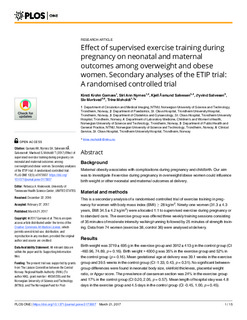| dc.contributor.author | Garnæs, Kirsti Krohn | |
| dc.contributor.author | Nyrnes, Siri Ann | |
| dc.contributor.author | Salvesen, Kjell Å | |
| dc.contributor.author | Salvesen, Øyvind | |
| dc.contributor.author | Mørkved, Siv | |
| dc.contributor.author | Moholdt, Trine | |
| dc.date.accessioned | 2017-08-24T06:43:24Z | |
| dc.date.available | 2017-08-24T06:43:24Z | |
| dc.date.created | 2017-06-02T14:18:48Z | |
| dc.date.issued | 2017 | |
| dc.identifier.issn | 1932-6203 | |
| dc.identifier.uri | http://hdl.handle.net/11250/2451659 | |
| dc.description.abstract | Background
Maternal obesity associates with complications during pregnancy and childbirth. Our aim was to investigate if exercise during pregnancy in overweight/obese women could influence birth weight or other neonatal and maternal outcomes at delivery.
Material and methods
This is a secondary analysis of a randomised controlled trial of exercise training in pregnancy for women with body mass index (BMI) ≥ 28 kg/m2. Ninety-one women (31.3 ± 4.3 years, BMI 34.5 ± 4.2 kg/m2) were allocated 1:1 to supervised exercise during pregnancy or to standard care. The exercise group was offered three weekly training sessions consisting of 35 minutes of moderate intensity walking/running followed by 25 minutes of strength training. Data from 74 women (exercise 38, control 36) were analysed at delivery.
Results
Birth weight was 3719 ± 695 g in the exercise group and 3912 ± 413 g in the control group (CI -460.96, 74.89, p = 0.16). Birth weight > 4000 g was 35% in the exercise group and 52% in the control group (p = 0.16). Mean gestational age at delivery was 39.1 weeks in the exercise group and 39.5 weeks in the control group (CI -1.33, 0.43, p = 0.31). No significant between-group differences were found in neonatal body size, skinfold thickness, placental weight ratio, or Apgar score. The prevalence of caesarean section was 24% in the exercise group and 17% in the control group (CI 0.20, 2.05, p = 0.57). Mean length of hospital stay was 4.8 days in the exercise group and 4.5 days in the control group (CI -0.45, 1.00, p = 0.45).
Conclusions
Offering supervised exercise during pregnancy for overweight and obese women did not influence birth weight or other neonatal and maternal outcomes at delivery. However our trial was limited by low sample size and poor adherence to the exercise protocol, and further research is needed. | nb_NO |
| dc.language.iso | eng | nb_NO |
| dc.publisher | Public Library of Science | nb_NO |
| dc.rights | Navngivelse 4.0 Internasjonal | * |
| dc.rights.uri | http://creativecommons.org/licenses/by/4.0/deed.no | * |
| dc.title | Effect of supervised exercise training during pregnancy on neonatal and maternal outcomes among overweight and obese women. Secondary analyses of the ETIP trial: A randomised controlled trial | nb_NO |
| dc.type | Journal article | nb_NO |
| dc.type | Peer reviewed | nb_NO |
| dc.description.version | publishedVersion | nb_NO |
| dc.source.volume | 12 | nb_NO |
| dc.source.journal | PLoS ONE | nb_NO |
| dc.source.issue | 3 | nb_NO |
| dc.identifier.doi | 10.1371/journal.pone.0173937 | |
| dc.identifier.cristin | 1473796 | |
| dc.description.localcode | © 2017 Garnæs et al. This is an open access article distributed under the terms of the Creative Commons Attribution License, which permits unrestricted use, distribution, and reproduction in any medium, provided the original author and source are credited. | nb_NO |
| cristin.unitcode | 194,65,25,0 | |
| cristin.unitcode | 194,65,10,0 | |
| cristin.unitcode | 194,65,20,0 | |
| cristin.unitname | Institutt for sirkulasjon og bildediagnostikk | |
| cristin.unitname | Institutt for laboratoriemedisin, barne- og kvinnesykdommer | |
| cristin.unitname | Institutt for samfunnsmedisin | |
| cristin.ispublished | true | |
| cristin.fulltext | original | |
| cristin.qualitycode | 1 | |

